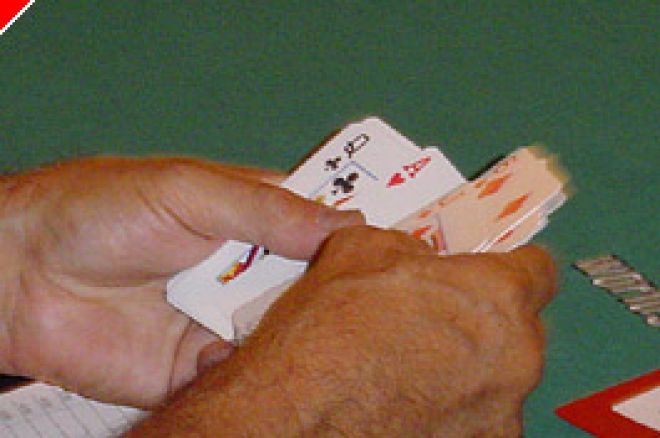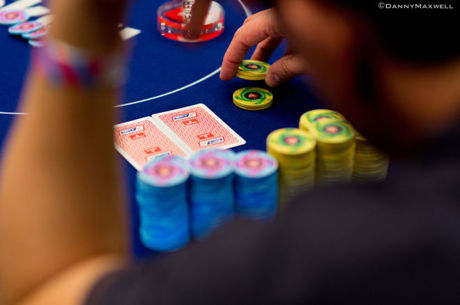Stud Poker Strategy - Re-raising in Stud

Let me get right to the point. Good but not great stud players generally need to change how they use the re-raise if they want to maximize their wins. Players who understand the importance of aggression when they are the lead hand on third Street often play too timidly when they face aggression. Change this behavior and add money to your bottom line.
Good players understand the need to be aggressive when they are in the lead. This is what separates them from the poor players who tend to be calling stations. They tend to raise if they think they're in the lead. And if they think they have sufficient pot odds but are still behind they'll usually call.
But this can't be done blindly. Though at the lowest stakes weak passive games, such a straight forward ABC ("by the book") style will generally get the money, as you rise to mid limit poker with generally tighter and more aggressive and less passive players, you must be more thoughtful. You must sometimes use your action to manipulate your opponent into making the wrong move.
Here's an example. The game is $10/20 stud, with a $1.00 ante and a $3.00 forced bet. The game is a typical mid-limit stud game: most players are pretty tight on Third Street – though there are a couple of loose passive players to make the game good. You're on Third Street with (A♥A♠)7♠. A player in front of you, who is pretty much an ABC player, raises with a King to $10. What do you do with four or so players remaining who haven't yet folded?
Most good but not great players want to come out shooting – tending to re-raise here – figuring that since they're the boss hand they want to make others pay to compete and don't want others to catch a card on fourth that could put them in the lead. So they make it $20.00. This is generally an error.
What they have done is follow too automatically what is generally a good rule. Their hand, while not trips, is the next best thing. This isn't a super loose and passive $1-5 game. They're not guaranteed of action if they re-raise. These are tight players for the most part. The player with the King may in fact be on a steal. Why deprive him of the chance to attempt his steal again on fourth? Why prevent any other players from coming into this hand? Even if you don't improve on fourth it's highly unlikely that you'll be behind. And if you catch a second pair or an Ace you're a heavy favorite to win on the river even with one or two opponents.
If the initial raiser has the Kings, take the aggressive stand of making him pay on later streets by not pushing him to fold. This is risky to some degree. The safer route is to raise. But have faith enough in the strength of this hand to risk someone else catching up. Timidity calls for a re-raise. Confidence allows for a call. So be strong and just call here – at least some of the time. You can raise him when he leads out with a bet on fourth – or even wait until fifth street sometimes to make your re-raise. Most of the time he'll just have his pair or will be extending his bluff. And in those instances when he catches two pair, you're not far behind with your overpair.
Here's another example. You have (Q♥A♠)Q♣ in the same situation. Aces and Queens are live. A King raises. You are probably, though not certainly, second best with your pair of Queens. But reraise – at least some of the time. Sure, the "safer" play is to call and hope you catch up with a second pair, an Ace or a Queen. But re-raise some of the time. His call will commit him further to the pot. If he re-raises you back you're still only fractionally behind. You should, at least sometimes, repop him and cap it. Let him think you have trips or pocket rockets. Keep him guessing.
These moves are difficult for the player relatively new to this level or one playing even slightly over his head. The amount of a reraise may seem like a lot of money in absolute terms in a $10/20 or $20/40 game. But relative to the size of a pot in a hand played to completion it is a relatively small sum of money. A re-raise in a $10/20 game costs $20. If the hand is played heads up with a bet and a call on all later streets then you're looking at a pot of about $170.
The key is to realize that you have an ability to manipulate your opponents by playing passively when you are almost surely ahead and aggressively when you may well be behind. Plus, you'll be enhancing your image as an aggressive player – which is good in this game because it will tend to inhibit your opponents from taking shots at you – making it less expensive for you to draw monster hands in the future.
When you're starting out it's very important to learn your ABCs. But when you're more advanced it's important that you become more than an ABC player.








